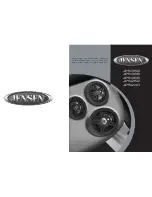
Factory Location
: Your new speakers have been designed to install into most
vehicles that accept a 2.5”/65 mm speaker. It is absolutely vital that the speaker
frame fits into the mounting hole cleanly. If factory location use only two holes, drill
the other 2 tor fix the speaker with all mounting holes. Do not tighten the speaker
onto an uneven mounting surface, this will damage it. The speaker should also fit
so that air does not leak around the mounting flange. Use the supplied soft foam
gasket to seal any air leak. If air gap is greater than gasket thickness, use an
automotive-grade sealant material. Use flat head screws type. Don’t use wood
screws, these use a conical head and can crack the basket frame.
Custom Location
: Select a desired mounting location with an even surface.
Tightening a speaker onto an uneven mounting surface can damage it. Mark the
center and the outline of the speaker’s mounting hole. Use a utility knife to cut any
fabric, vinyl or leather from hole locations. Drill a pilot hole in the center of the
proposed speaker mounting hole. Then make the circular cut out for the speaker.
After cutting the hole, check to see that the speaker frame fits into its mounting
hole cleanly. Once the speaker is in place, use the speaker’s mounting holes to
mark the panel where the four mounting screws will be positioned.
Remove the speaker and drill 2 mm holes at each mark. Connect the speaker
wires, observing correct polarity, and be sure wires don’t touch any metal part.
Make sure the speaker is secured so that air does not leak around the mounting
flange. Hand-tighten the screws evenly in a criss-cross pattern to avoid bending
the speaker frame or stripping the mounting screw holes. Finally, mount the grille,
insert it into the grille gap, pressing around its edge until seated firmly in the gap.
WIRING YOUR SPEAKER
If you will be using the factory speaker wires, it may be necessary to change the
terminations. This may be accomplished by using an adaptor plug or simply by
cutting the factory connector off and using the crimp connectors to terminate the
speaker wires. The red mark connector is for the positive terminal and black mark
connector is for the negative terminal of the speaker. If you choose to run new
speaker wires, protect all wiring from sharp edges by carefully routing them, securing
them and using grommets and loom where appropriate. If you are running wires into
a door, use existing factory wiring boots whenever possible. If you are drilling new
holes, file their edges and install rubber grommets into each hole. Wires running
into car doors should be covered with a protective, flexible PVC sleeve. Make sure
that the wires will clear door hinges and other structures in the door.
This component need a crossover system, you can chose passive or active as well.
The crossover must be high pass type if component is used as widerange, or
band-pass if component is used as midrange. The minimum suggested cutting
frequency is 100 Hz at 48dB/Oct slope, you can reduce the slope, but remember
to reduce the power driving or increase cut-off frequency respectively at 150 Hz
for 24 dB/Oct, at 200 Hz for 12 dB/Oct and at 250 Hz for 6 dB/Oct. These cut-off
frequencies are only suggested, right frequency must be calculated and tested
directly inside the car, and depend of speaker location, listening angle and car’s
passenger conformation
.









































